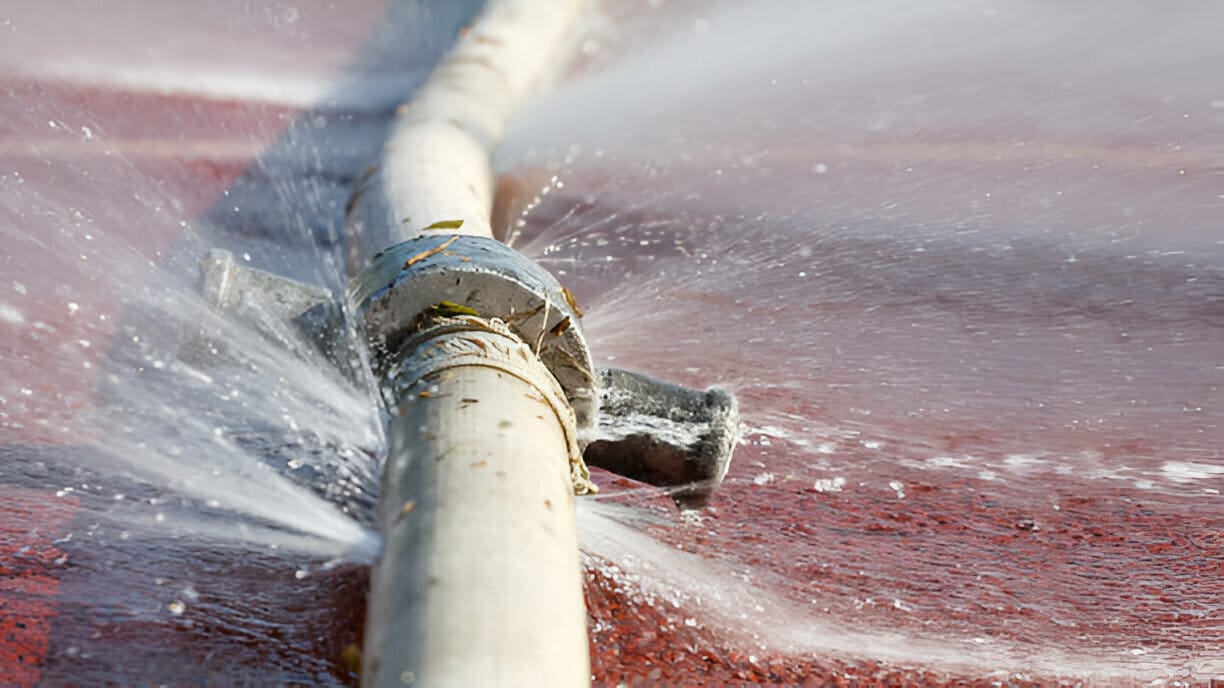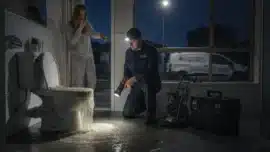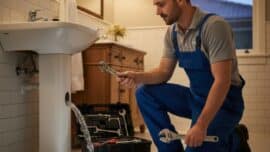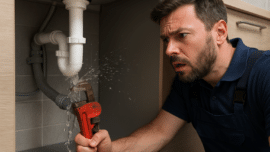
15 Things You Should Do When You Find a Burst Pipe
Facing burst pipes in your home can be a daunting experience, often leading to immediate water damage and the potential for mould growth if not addressed promptly. We understand the importance of quick actions and effective solutions in these situations to minimise damage and restore your property’s safety. It’s essential to tackle the problem head-on to prevent further damages and costly repairs, and dealing with burst pipe water damage requires knowledge and preparedness to handle the situation efficiently.
In this article, we outline a strategy to manage the aftermath of burst pipes, from identifying the cause of the burst to cleaning and removing stagnant water, and applying temporary solutions for containment. Our goal is to guide you through re-evaluating and replacing damaged sections, ensuring a comprehensive approach to mitigate the impact. By following these steps, you can effectively address both the immediate and long-term consequences of damaged and broken pipes, safeguarding your home from additional harm. Through informed decisions and proactive measures, we aim to empower you to manage burst pipe incidents confidently and competently.
Identify the Cause of the Burst
Identifying the cause of burst pipes is crucial to prevent future occurrences and mitigate damage. Here are some common causes and preventative measures:
Common Causes of Pipe Bursts
- Freezing Temperatures: Water expands when it freezes, putting immense pressure on pipes, which can cause them to burst.
- Corrosion and Rust: Continuous exposure to elements can corrode pipes, weakening their structure and leading to bursts.
- High Water Pressure: Pipes can only handle certain levels of pressure; excessive pressure can cause them to fail.
- Clogs and Blockages: These create backpressure, which can lead to pipe bursts.
- Ageing and Wear: Over time, pipes can deteriorate due to various environmental factors and physical stress.
How to Prevent Them in the Future
- Insulation: Protect pipes from extreme temperatures to prevent freezing.
- Regular Inspections: Check for signs of wear, corrosion, and damage to address issues early.
- Pressure Management: Install pressure-reducing valves to maintain safe water pressure levels.
- Proper Installation and Maintenance: Ensure pipes are correctly installed and promptly repair any damages.
By understanding these factors and implementing preventative measures, we can significantly reduce the risk of pipe bursts. For expert assistance, South East Plumbing Engadine offers comprehensive services to help maintain your plumbing system and prevent such issues.
Clean and Remove Stagnant Water
When dealing with burst pipes, promptly removing stagnant water is crucial to mitigate damage. Here’s how we can tackle this effectively:
Techniques to Remove Water Safely
Firstly, assess the extent of water accumulation. For minor leaks, mopping up with towels might suffice. In cases of more significant flooding, employing a wet-dry vacuum is essential. South East Plumbing Engadine recommends using a wet-dry vacuum to efficiently remove water from all affected surfaces, including floors and carpets. This method ensures that most of the water is extracted, reducing the risk of mould and further damage.
Using Vacuum or Squeegee
For areas with extensive water, a squeegee can be used to push water towards exits like garage doors or drains, facilitating quicker removal. If you have access to a wet-dry vacuum, use it to suck up water from carpets and hard surfaces. Remember to focus on areas that are prone to water damage, such as wood floors and drywall, to prevent the water from seeping further and causing structural issues.
Temporary Solutions for Containment
When you encounter burst pipes, immediate containment is crucial to prevent further damage. Here are two effective temporary solutions:
Applying Pipe Repair Tape
For small leaks, Wrap & Seal Pipe Burst Tape is an excellent choice. This self-fusing silicone tape can seal leaks even under pressure, making it ideal for emergency situations. To use, stretch the tape to its maximum, wrap it tightly over the crack, and ensure each layer fuses into a solid rubber band for a secure seal. South East Plumbing Engadine recommends using multiple layers to increase the pressure resistance of the repair.
Using a Compression Repair Kit
For larger leaks or joint issues, a compression repair kit provides a quick fix. These kits usually include epoxy putty or specialised resin-permeated fibreglass tape, which is activated by water. Clean and dry the affected area, apply the putty or wrap the tape around the pipe, and allow it to cure as per the kit’s instructions. This method can offer a temporary or even longer-term solution depending on the kit used and the condition of the rest of the pipe.
Re-evaluate and Replace Damaged Sections
To effectively address burst pipes, it’s crucial to re-evaluate and replace damaged sections accurately. Here’s how we can manage this critical process:
How to Spot Compromised Pipe Sections
Firstly, inspect for visible signs of damage such as discoloured water, unusual water pressure, or wet spots on walls and floors. These indicators often point to the locations where pipes have deteriorated or burst. Regular inspections, especially near potential problem areas like tree roots or old piping, are essential to catch issues early before they escalate.
Steps to Replace Parts
- Shut Off the Water Supply: Locate and turn off the main water valve to prevent further damage.
- Cut the Damaged Section: Use a pipe cutter to remove the compromised area cleanly.
- Measure and Cut the Replacement Pipe: Ensure the new pipe matches the dimensions and material of the old one.
- Install Slip Coupling and The New Pipe: Secure the new section with slip couplings, avoiding over-tightening to prevent stress on the pipes.
For assistance with complex replacements or if the damage is extensive, South East Plumbing Engadine is equipped to ensure professional and reliable repairs.
Navigating through the aftermath of burst pipes calls for a methodical response, honed by a clear understanding of the causes, preventive measures, and effective containment strategies. This article has laid out a comprehensive framework, guiding you from initial damage assessment through to the meticulous repair and replacement of damaged pipe sections. The implications of such events are far-reaching, affecting not just the immediate state of your property but also its long-term integrity. It’s the kind of situation where the knowledge and expertise of a professional can make a world of difference, which is where South East Plumbing Engadine steps in, equipped to not only mitigate the damage but to ensure your plumbing system withstands the test of time and varying conditions.
In facing the challenge of burst pipes, the value of swift, informed action cannot be overstated. By applying the outlined steps and solutions, you are not just restoring order to your home but actively safeguarding it against future compromises. The role of specialised assistance in such scenarios proves invaluable, reinforcing the importance of accessing dependable services when they are most needed. For those seeking expert guidance and reliable solutions, seplumbing.com.au can provide the reassurance and quality care your home deserves. From preventive maintenance to emergency repairs, their experienced team stands ready to support you, ensuring that the comfort and safety of your home are uncompromised.
Frequently Asked Questions
What immediate actions should be taken if a pipe bursts?
If you discover a burst pipe, it's crucial to act quickly to limit water damage. Immediately turn off your home's water supply at the stop taps and ensure your central heating boiler is also turned off. Next, drain the water system to prevent more water from escaping and use towels or other absorbents to soak up or block the escaping water. Finally, contact a plumber to repair the damaged pipe.
How can you repair a burst pipe yourself?
To repair a burst pipe, start by shutting off the water supply to stop any further water flow. Locate the damaged section of the pipe and assess where a new fitting might be necessary. Drain any remaining water from the pipes, then measure and cut the copper pipe to the appropriate length. Clean the ends of the pipes and the new valve, apply flux, and connect the pieces. Ensure all connections are secure.
How do you stop water flow from a burst pipe?
As soon as you detect a burst pipe, immediately shut off the main water valve to your house. This action stops any additional water from flowing through the damaged pipe. The main water shut-off valve is typically located near the water metre or where the main water line enters your home.
What steps should you follow if a pipe bursts inside your wall?
If a pipe bursts within a wall, first shut off the main water valve to minimise further water damage. Open all faucets connected to the line to drain the remaining water in the system. Contact a professional plumber to handle the repair. Begin removing any water that has accumulated to prevent further damage and mould growth. Lastly, inform your insurance provider about the incident to discuss potential coverage for repairs.



